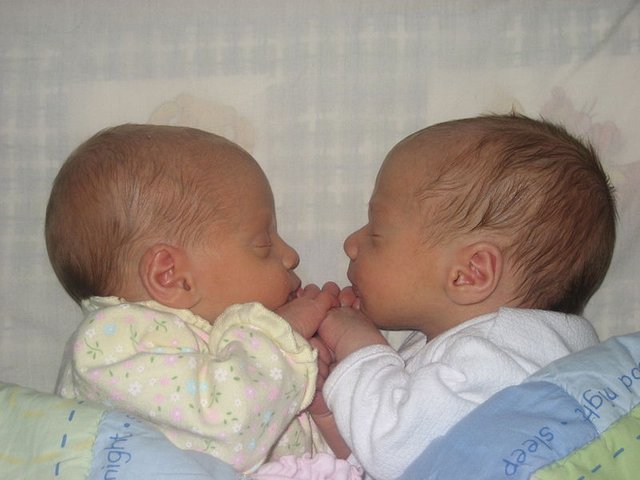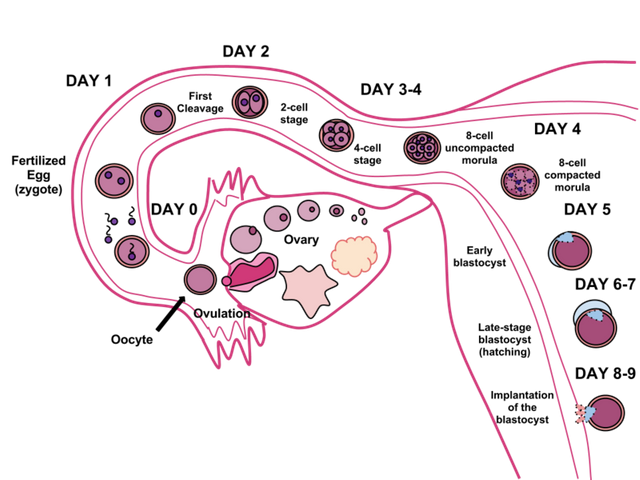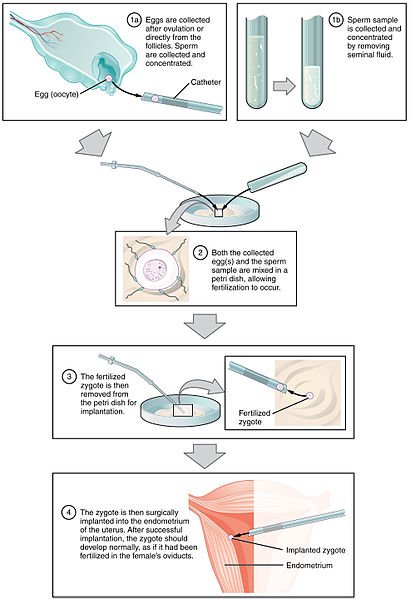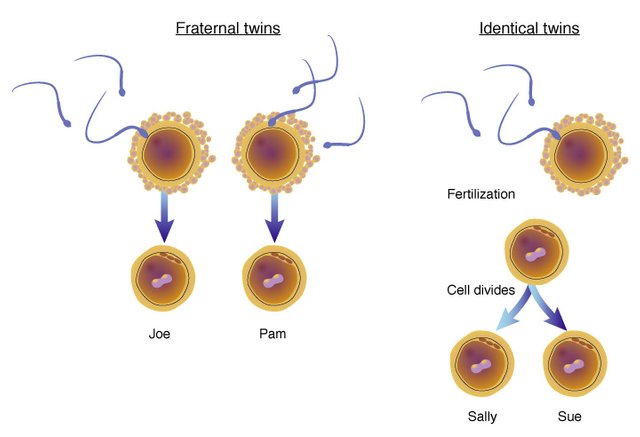UNRAVELING THE BIOLOGY BEHIND HETEROPATERNAL SUPERFECUNDATION- twins with different fathers in a pregnant woman
Five days ago I was involved in a deep-heated and serious argument with my colleague in the field of medicine and the topic of debate was about conception. We were actually discussing about a concept I regarded as a mere hypothesis, during the course of our conversation he raised a condition associated with conception and to be frank, I had never at any point in my life thought it would be really possible , this was no other than - Heteropaternal Superfecundation(HS).
At first I was marveled at the word and also coupled with the fact that he said this word with such an ease, the whole thing silenced me for a while. How on earth is this possible? That was the question I asked out of curiosity. Been a learned man also, I held my peace in anticipation that he will throw more light on what he was talking about. The discussion went deep and I can tell you it was really an intense argument. Not satisfied with the reason he gave while explaining the rare condition he mentioned, I decided to go deep into research. Well today, I am now well equipped to share this topic with you, join me as I take to through HS, you are sure to learn a lot from this.
The concept of HS
No need worrying about the that long name, you are likely to bite your tongue in the process, I will use HS for convenience sake.
Science has proven that when a male and a female come together to copulate, the end result is supposed to be fertilization leading to the formation of a zygote.
Further development leads to the formation of an embryo which undergoes further developmental stages in the womb of the female. Sometimes, the result of the mating could lead to double embryo formation also known as twins. This is a normal physiologic process that happens in humans (females) but a situation can arise whereby two embryos are produced but they are not from one man, that is, a woman carries twins that are not from one man rather they are as a result of fertilization by the sperm of two different men. Strange isn’t it?
This is really against the normal process of foetus formation. Today, I want to introduce you to the condition known as Heteropaternal Superfecundation (HS) a rare but real condition. According to forensic science international,
Heteropaternal superfecundation (HS) is a phenomenon that occurs as a result of fertilization of two eggs in the same cycle of ovulation, either during the same sexual intercourse when ovulations are simultaneous or, with intervals between 3 and 9 days when ovulations are discordant, at the same menstrual cycle, but containing sperm from different men, resulting into fraternal or dizygotic twins who, unlike full siblings that share about 50% of their genome, only share an average of 25% of it.
The normal conception process in women
Generally it believed that a woman is not expected to be pregnant again once she has conceived. Conceive here means that a sperm from one man has already fused with an ovum in the woman and resulting to a zygote. When sperms are released by the man into the woman through the vaginal orifice, these sperms quickly travel through the wall of the vagina to the cervix. Their movement is enhanced by the mucous fluid in the vagina. As they reach the cervix, they further migrate at a speed of about 3mm/min to the ampulla of the fallopian tube.
The journey of these sperms from the vagina after ejaculation from men to the ampulla takes roughly 30-60minutes and at this point, they meet an egg and fuse to a layer of membrane called zona pellucida (a lipid layer that surrounds the egg) with their head. Once this sperm has fused, the nucleus of the sperm is released into the egg, union of both results to the formation of an embryo.
Now one interesting thing that happens after the sperm head fuses with the membrane of the egg is that, it it makes the membrane less susceptible to other sperms i.e it in decreases the affinity of the membrane to other sperms thereby ensuring that any other sperm that comes to fuse won't be able to penetrate. Wao, isn’t that brilliant? The video here shows how the sperm swims and attaches to an ovum for fertilization. As the sperm penetrates, the tail remains outside and later is cut off. Look closely and observe the sperm cell that is forcing itself into the egg.
This is basically what happens when a man releases millions of sperms in a female. Having said all the above, here comes the big question.
Why then heteropaternal superfecundation?
The explanation given below has not been fully accepted around the world as the major or conclusive cause of HS. Though the reason might seem convincing enough, but it is not conclusive. A lot of factors come into play when dealing or trying to use human embryo as an experiment. The real mechanism of HS is still not well understood up till date. Read along and you will find out why.
HS mainly occurs when two different men are responsible for a pregnancy in a female fraternal thus resulting to fraternal twins.
Since the female body system is programmed to inhibit or stop further fertilization of eggs by sperm, how then is it possible for a woman be pregnant with fraternal twin babies after having sex with two different men?
The reason is this, when a sperm is released, this sperm can actually remain viable or active and can stay for about four to five days in the oviduct of the female waiting or scanning and looking for an egg it will fertilize, failure to find an eggs leads to its deterioration and death. The egg on the other when released during ovulation only has about twenty (24) to forty eight hours 48 hours to stay after which it begins to disintegrates.
This invariably means that the total time the sperm can stay in the female is about 5 -7 days. During this period, a lot of things can happen when things go wrong with the normal physiologic system involved in conception. If peradventure the woman who has slept with a man gets pregnant and then after some days sleeps with another man, provided the normal mechanism of conception I earlier explained above is not in places or not in normal state, HS is likely to occur. Although this condition is a rare one, but the fact remains that it is real. HS can either occur during normal sexual intercourse or during the process of artificially insemination, a situation where the egg of a woman and the sperm of a man is artificially fertilized in the laboratory and then the zygote formed is transferred into a woman who is unable to conceive a baby.
This procedure is also known as in-vitro fertilization (IVF). During the process of IVF, it is very possible that more than one fertilized eggs are inseminated into the woman, thus resulting to different implantation at different sites.
Assuming the couple had sex before the woman is artificially inseminated with an in-vitro fertilized egg (egg fertilized in the laboratory inside a tube), provided the sperm released by the man is still viable i.e. its duration of stay inside the uterus is still within 5-7 days, there is a high chance of one blastocyst to be implanted inside the womb of the woman, thus resulting to one embryo biologically from the husband and another embryo from the IVF.
Documented cases so far indicated that the likelihood of heteropaternal superfecundation is associated more with invitro fertilization.
Why do some twins differ ?
Ever wondered how twins either identical or fraternal twins are formed? In the case of identical twins, it occurs when a single sperm fuses with an egg, the fusion results to splitting of the egg into two identical forms while in the case of fraternal twins, two separate eggs are fertilized by different sperms but from one man, this case is as well known as homopaternal superfecundation.
If you reason along with me, what this invariably means is that heteropaternal superfecundation is actually a type of twining resulting to twin babies that are not identical. In the case of heteropaternal superfecundation, the babies as well are not identical but the difference here is that, they are from different fathers.
Reported cases of HS
A lot of cases have been reported so far about this condition, the first case of heteropaternal superfecundation was reported in 1982. The twins had different colour of skin and further investigation revealed that they were both from different fathers.
A more recent case that occurred in April 2016 is that of a female by name Jessica Allen who decided to play the role of a surrogate mother. She was artificially inseminated through IVF,
after a period of six weeks of been pregnant, never did it occur to her that she was carrying two babies in her womb. Guess what, these babies were actually fraternal twins and the most shocking news was that the babies were of two different fathers, one from her husband and one from the artificially inseminated.
I know the question now is- how did they know that the babies were of different fathers? The answer is quite simple, the DNA test conducted on the babies revealed the whole information. Science has gone far beyond what we see here.
The father’s DNA result only matched with one of the baby while the other matched with that of the artificially inseminated.
Barrier to further research on Heteropaternal Superfecundation
Despite the few explanations given by various medical experts around the world, it is still not very clear how HS occurs. Most of the explanations given are not concrete enough to ascertain the actual cause of HS but they are also factors to consider. According to the report from American journal of obstetrics and gynaecology one of the limitations to further research about this occurrence is due to the ethical issues surrounding human embryos.
Human embryos are treated as humans in general and as such, cannot be subject to unfair laboratory experimentations. This is similar to the case of cloning if human beings. Were it not for the strong intervention of regulatory bodies like WHO and other human right organizations, thousands of clones would have been on the streets.
These embryos are basically humans yet to be formed, they are divine creatures, and they have that same intrinsic value as being called humans. Even though most research are targeted at discovering the cause, proffering solutions that will alleviate the sufferings of humans; the inalienable and fundamental human right -right to life remains non-negotiable. This is the major barrier impeding research associated with embryos. This is also backed up with the Universal declaration of human rights. Art. 3 of this law states that no one or human may be subjected to torture or to inhuman or degrading treatment or punishment. Since the embryo is under the ambient of being regarded as human.
An article published by the Electronic Journal of Comparative Law in Netherlands, shows that they have a bill that protects the right of the embryo as human. According to this bill,
the embryo is a cell or a connected aggregate of cells with the capacity to develop into a human being thus, shall not be in anyway maltreated.
There are a lot of laws prohibiting the use of embryo as an experiment and this had made in-depth research into the cause of HS very difficult in humans. All the laws are in one way or the other ensuring that the dignity of man is protected, be it embryo or full grown being.
Conclusion
HS is quite rare but the truth remains that it does exist. The possibility of a woman conceiving twice in one sexual cycle i.e. one menstrual cycle is real. As long as two eggs are released after ovulation, if the woman sleeps with two men, there is a very high chance of Heteropaternal Superfecundation occurring. This is possible because sperms from the two different men can fertilize two different eggs.
All thanks to my ingenuous colleague for revealing such a wonderful topic of discussion.
Thanks for reading.
References and further reading
•The society of obstetricians and gynecologists of Canada
•wikipedia-superfecundation
•twins with different fathers
•cnn-news
•forensic science journal
•A review of the mechanisms and evidence for typical and atypical twinning
•Key ethical issues in embryonic stem cell research- parliament of Australia
•Rights of a human embryo

A proud member of @steemstem and @stemng community. If you write Science, Technology, Engineering and Mathematics related post, consider joining the community.




.jpg)
thanks for very interesting and informative article that explains rare and complicated phenomena in easy to understand words
Thanks for coming around
This is the first post I am reading this morning and it really does worth the time. One thing about medical conditions is that you can never know all. I never knew such a condition existed. The explanations even if not widely accepted yet are logical enough.
Thanks for sharing this knowledge, some men will now be suspicious of their twin children that are too "non-identical" and where one of the two has weird characters that can't be traced to him or his wife, lol.
Lol..... Yeah
I trust naija men
Thanks for coming around
I am truly amazed by this, this could mean that there could be a lot of HS twins in Nigeria and no one would know since DNA test is rarely done here
Yeah, you are very correct.!
I can't but say I am wowed. The whole concept and content is astounding. Two different father's babies in one womb. Chai!
Yeah,it really does
This is a really well-written article. Well done! Have you ever heard about a condition called Uterus didelphys? It is a condition whereby a woman has two uteruses instead of one. She can carry two babies at the same time (even from two different men) but both of the babies were not considered as a twin as they developed in two different uteruses. The woman can even have two vaginas which, in my opinion, is freaking weird.
Thanks for this addition, my first reading about Uterus didelphys. A lot of weird terminologies in the medical world though
Yeah, I have heard about that.... Quite rare as well.
Most of those are genetic abnormality during embryogenesis.
Thanks for this, it added more flesh to the discussion
Very informative post bro.
I'd always thought of what would happen in the case of 2 men sleeping simultaneously with one woman, like in the case of a threesome. This has done part justice to my curiosity.
Plus, I've found a word to use to brag today. Lol.
Lol..... Brag well
Learning is fun, thanks for coming around bro
Great work. Well researched. God bless you for making me learn this. You just got me informed!
You are welcomed
Incredible!
Hi @cyprianj!
Your post was upvoted by utopian.io in cooperation with steemstem - supporting knowledge, innovation and technological advancement on the Steem Blockchain.
Contribute to Open Source with utopian.io
Learn how to contribute on our website and join the new open source economy.
Want to chat? Join the Utopian Community on Discord https://discord.gg/h52nFrV
Congratulations @cyprianj! You have completed the following achievement on Steemit and have been rewarded with new badge(s) :
Click on the badge to view your Board of Honor.
If you no longer want to receive notifications, reply to this comment with the word
STOPDo not miss the last post from @steemitboard:
SteemitBoard World Cup Contest - Round of 16 - Day 4
Participate in the SteemitBoard World Cup Contest!
Collect World Cup badges and win free SBD
Support the Gold Sponsors of the contest: @good-karma and @lukestokes